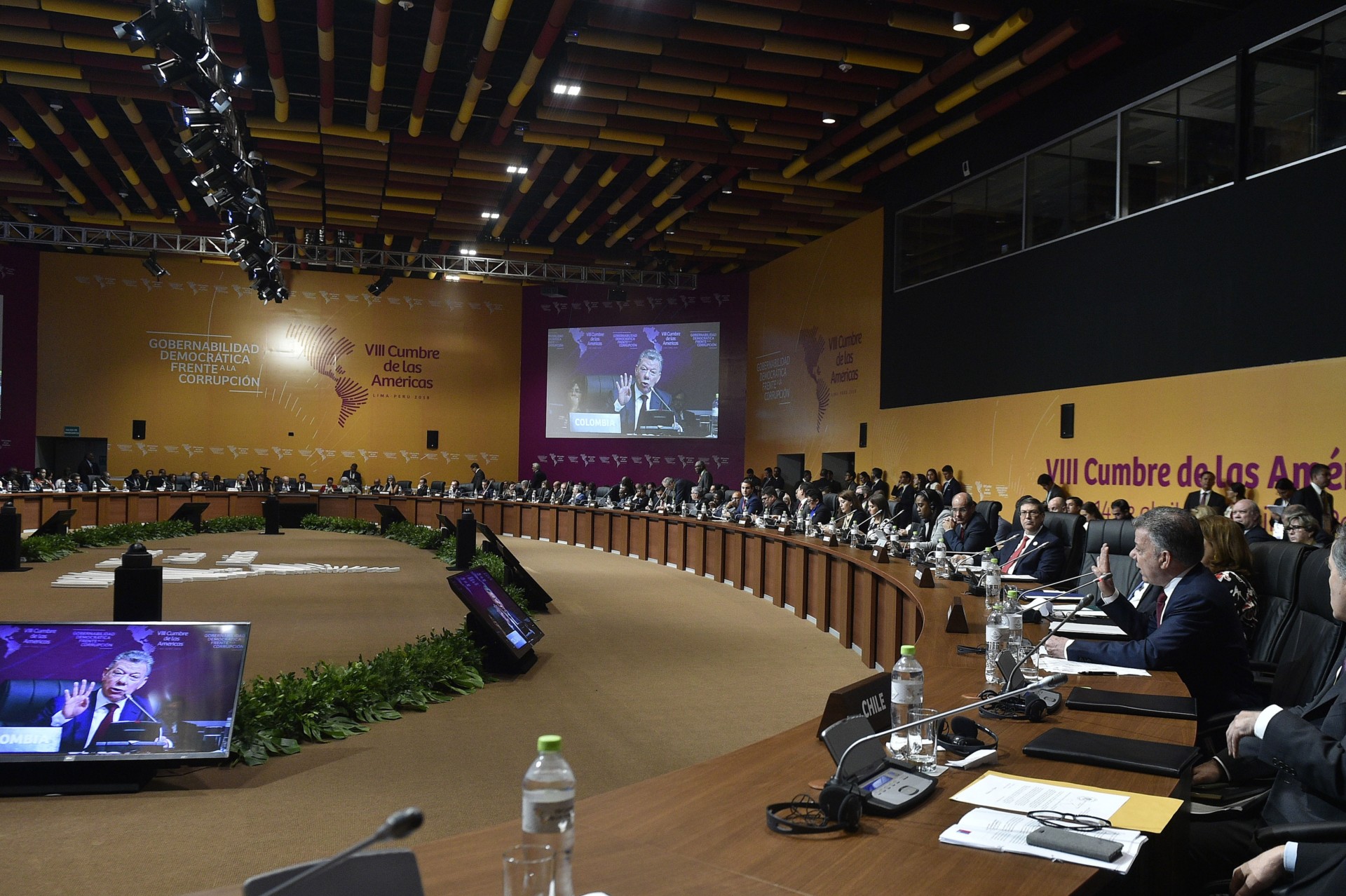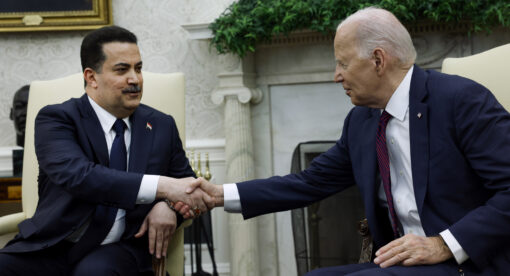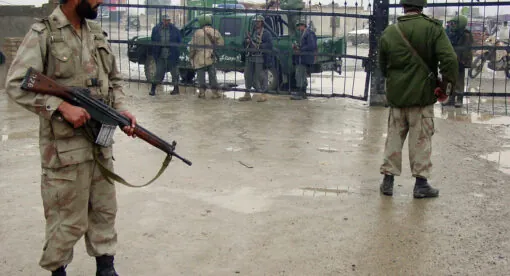Listen to article
This June, Los Angeles is set to host the largest meeting of regional heads of state, the Summit of the Americas 2022. The summit, held every three to four years, provides a space for the Western Hemisphere’s leaders to discuss common policy issues, affirm shared values, address challenges in the region, and determine mandates for action. However, given the current state of affairs between the United States and the rest of the hemisphere, regional leaders have threatened to boycott the event altogether, and the host country is ambiguous about the agenda and the guest list. If the summit fails because key actors in regional politics are absent and no significant agreements can be made, Washington runs the risk that it could be the debut of an illiberal alliance within Latin America that could give China and Russia the opportunity to enter into direct competition with the United States.
The Latin American region has seen the rise of leaders like Mexican President Manuel Lopez Obrador and Argentine President Alberto Fernandez, who are looking to distance themselves from Washington’s influence and seek external allies to improve their country’s standing, regardless of ideological standards. China and Russia, meanwhile, have increased their influence in the region since the early 2000s. The summit could force the U.S. administration to choose between its main campaign pillars: sustaining democracy and curbing China’s influence.
Difficulties and Disagreements
The 2022 summit represents the current state of affairs between the United States and most Latin American countries. As the administration acknowledges the challenges outside and inside forces are posing to the summit, it is also taking account how Latin American countries perceive themselves concerning the United States. First Lady Jill Biden’s trip to six South American countries shows an effort to engage with longstanding allies, such as Panama, Costa Rica, and Ecuador, while trying to persuade them to attend the summit. This summit was first imagined as an opportunity to institutionalize meetings within the highest levels of government in the region to create coordinated actions, with what at the time were 34 democratic nations.
U.S. President Joe Biden now faces a conundrum. He could maintain the forum’s original “democracies only” status that coincides with his administration’s pillars. Alternately, he could engage with non-democracies in order to find a coordinated approach to issues like the record number of migrants trying to enter the U.S. or the recent economic decline experienced by most countries in the region.
Talking with non-democracies does not seem to be a compromise Biden is willing to make, as he recently highlighted in his speech in Warsaw, where he displayed his vision of an apparent battle between democracy and autocracy. Holding this line of thought is the announcement of the preference to include only democratically elected leaders in the summit’s guest list at the beginning of the year. And even though invitations had not been sent as of May 24, there are strong rumors that Cuba, Nicaragua, and Venezuela will not be on the guest list for this year’s meetings.
Regardless of how expected the news was, it was not taken lightly in the region. Mexico’s Lopez Obrador, who has made a point of stirring public opinion against the U.S., called for a boycott of the summit if Washington decided to exclude countries. The Caricom countries – 14 of the countries invited to the summit – echoed this sentiment. Argentina’s Fernández also joined this call for no exclusion. Bolivia and Chile also threatened to boycott the summit if all countries in the region were not included.
These countries’ main argument is that regional issues cannot be resolved without every country in the region. However, there are other factors to consider since regional solidarity is hardly the only explanation for this sentiment. For instance, Fernández’s declaration is in line with his interests in distancing his country from Washington.
Latin America’s Dissatisfaction with U.S. Policy
Incoming leaders have shaken Latin America with their strong personalities seeking to distance themselves from the U.S.’s line of thinking and put their countries’ needs first. And the U.S. has been either slow to respond or completely underestimated how much of a challenge they could present. The threats to boycott the summit appear more like a response from prominent Latin American personalities to the United States’ neglect of the region and how U.S. policy for the past decades has focused on short-term transactions instead of sustaining long-term relationships.
Regional leaders are standing up to a United States that cannot offer the same benefits it could when the summit was first created. In 1994, a promise of free trade agreements incentivized many countries’ participation. Today, the United States holds 20 free trade agreements, 13 of which involve Latin American countries including Chile, Colombia, Costa Rica, Honduras, and Mexico. But most of these treaties are over a decade old and have been criticized by new leaders, like incoming Honduran President Xiomara Castro de Zelaya, who is calling for a revision of the Central America-Dominican Republic Free Trade Agreement for not meeting the countries’ needs.
Furthermore, diplomatic efforts within the region have stalled. The United States has 12 unfilled ambassador positions in the Western Hemisphere. Out of the 12, seven nominations are stalled in the Senate. Even Biden’s nominee for head of the Organization of American States is delayed. This shows how pressing the U.S. Senate considers these positions in particular and ambassadorships in general; more than 50 ambassadorships are stalled in the Senate, showing the body’s disengagement from foreign affairs. The only interest Washington keeps pressing on with the region are migration issues. However, it is unwilling to form long-term partnerships with Central American countries to dig into the underlying issues and find a long-term solution to the core causes of migration, signaling to these countries that there is no lasting commitment in the region.
The defiance over the summit also comes from a region that feels overlooked in its time of need. It has been heavily impacted by the COVID-19 pandemic and has been plagued by political instability over the past decade. According to the IMF, the region experienced a 7% economic contraction in 2020, the sharpest in the world. This set of circumstances has created an opportunity for Russia and China to exploit, militarily and economically.
China’s influence in Latin America has been growing since 2000. Today, China is South America’s top trading partner, increasing trade from almost $18 billion in 2002 to nearly $449 billion in 2021. China’s efforts have also expanded to diplomatic actions as more countries in the Western Hemisphere shift their alliances from Taipei to Beijing. Taiwan has 14 democratic allies left, and eight are in the Latin American and Caribbean regions. The last three countries to shift alliances to Beijing were Panama, Nicaragua, and the Dominican Republic. However, it is no coincidence that after these countries shifted away from Taiwan, Beijing rewarded them with major economic investment. In El Salvador, for example, Beijing committed to finance various infrastructure projects of around $500 million after the government shifted alliances.
Similarly, Russia’s influence has been expanding in the region since 2008. Taking advantage of the political changes within the region and the leftist political ideology that has accompanied most of these changes. Russia increased its diplomatic influence in the region and expanded its military alliances, by investing heavily in security and trade. Russia’s trade in the region increased by 44 percent, between 2006 and 2016. These diplomatic ties presented the Latin American countries with a conundrum over how to react to Russia’s invasion of Ukraine, resulting in various responses to Russia’s actions, varying from condemnation, to full support for the invasion.
What Can Washington Do?
The Biden administration should recognize that although democracy is a pillar for the United States, the Latin American countries are becoming increasingly ambivalent toward it. The crisis in Venezuela has produced over 6 million refugees; Colombia, Peru, Chile, and Ecuador have received the highest number of them, while struggling with their own internal economic and social issues. Following U.S. guidelines, the region’s countries had isolated Venezuela to sanction its human rights abuses and its democratic backsliding. Still, leaders like Argentina’s Fernández and Ecuadorian President Guillermo Lasso are raising the question of resuming relations with Venezuelan Leader Nicolas Maduro to find joint solutions to the region’s crisis.
The U.S. still holds a chance to remind Latin American countries why they need to present strength and unity regarding democratic ideas. The Biden administration should use its relationship with countries like Colombia and Costa Rica and use policies to strengthen smaller group relationships, like the policies it is applying to counter China’s rise in the Indo-Pacific. One of the big agenda points pushed by the Biden administration was renewable energy; with Latin America being one of the most dynamic renewable energy markets in the world, finding points the Americas can work on together is critical. There also needs to be a stronger focus on these aspects, more than just saying that the summit will focus on building a sustainable, resilient, and equitable future. The U.S. needs to steer the conversation away from what it cannot provide and into how the hemisphere can find a path forward together and through this summit.
The 2022 summit should not be a mystery; a clear agenda needs to be established, and with it, a sustainable plan with the participating countries to achieve the goals the summit agrees on. With clear objectives and a willingness to assist the region in finding joint economic and social solutions to the regional crisis, Washington could incentivize attendance at the summit. For instance, recent U.S. actions toward Venezuela and Cuba persuaded 13 of the 14 Caricom countries to join the summit. Brazilian President Jair Bolsonaro, who was among those threatening to boycott the summit, has just confirmed his attendance.
If the U.S. does not attempt to recover and strengthen its relationships with the Latin American countries through this summit and other actions, it runs the risk of these relationships changing permanently.
Claudia Gago is currently pursuing a Master of Arts in Law and Diplomacy at The Fletcher School. She is the research intern for the State Resilience and Fragility Program at The New Lines Institute for Strategy and Policy, and her primary focus is on Latin America. She tweets at @gaguitoclaudia
The views expressed in this article are those of the author and not an official policy or position of the New Lines Institute.







